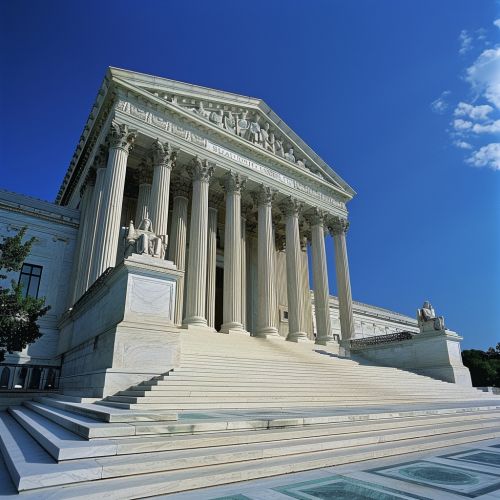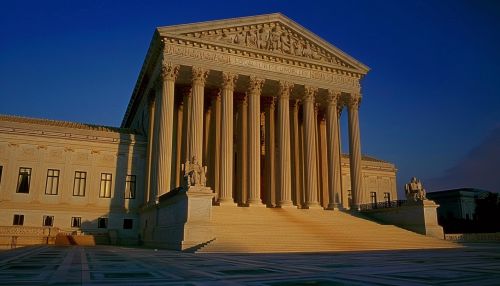Brandenburg v. Ohio: Difference between revisions
(Created page with "== Background == Brandenburg v. Ohio is a landmark decision of the United States Supreme Court that was decided on June 9, 1969. This case is significant for its interpretation of the First Amendment to the United States Constitution, specifically concerning the limits of free speech and the advocacy of illegal activities. The case arose when Clarence Brandenburg, a leader of the Ku Klux Klan, was convicted under Ohio's criminal syndicalism law for advocating violenc...") |
No edit summary |
||
| Line 16: | Line 16: | ||
The Court's decision was grounded in the principle that the government cannot punish inflammatory speech unless it is likely to incite imminent lawless action. The ruling emphasized the importance of protecting free speech, even if the speech is offensive or controversial, as long as it does not pose a clear and present danger of inciting illegal activities. | The Court's decision was grounded in the principle that the government cannot punish inflammatory speech unless it is likely to incite imminent lawless action. The ruling emphasized the importance of protecting free speech, even if the speech is offensive or controversial, as long as it does not pose a clear and present danger of inciting illegal activities. | ||
[[Image:Detail-92111.jpg|thumb|center|The United States Supreme Court building, a neoclassical structure with a large staircase leading up to a row of tall columns.|class=only_on_mobile]] | |||
[[Image:Detail-92112.jpg|thumb|center|The United States Supreme Court building, a neoclassical structure with a large staircase leading up to a row of tall columns.|class=only_on_desktop]] | |||
== Impact and Significance == | == Impact and Significance == | ||
Latest revision as of 04:01, 18 June 2024
Background
Brandenburg v. Ohio is a landmark decision of the United States Supreme Court that was decided on June 9, 1969. This case is significant for its interpretation of the First Amendment to the United States Constitution, specifically concerning the limits of free speech and the advocacy of illegal activities. The case arose when Clarence Brandenburg, a leader of the Ku Klux Klan, was convicted under Ohio's criminal syndicalism law for advocating violence during a speech at a Klan rally.
Case Details
Facts of the Case
In 1964, Clarence Brandenburg, a Ku Klux Klan leader in Ohio, invited a Cincinnati television station to cover a Klan rally. During the rally, Brandenburg made a speech that included derogatory remarks about African Americans and Jews, and he suggested the possibility of "revengeance" against the government if it continued to suppress the white race. Brandenburg was subsequently charged and convicted under Ohio's criminal syndicalism law, which prohibited advocating violence as a means of political reform.
Legal Proceedings
Brandenburg was fined $1,000 and sentenced to one to ten years in prison. He appealed his conviction, arguing that the Ohio law violated his First Amendment rights to free speech. The Ohio courts upheld his conviction, and Brandenburg then appealed to the United States Supreme Court.
Supreme Court Decision
Majority Opinion
The Supreme Court, in a per curiam opinion, reversed Brandenburg's conviction. The Court held that the Ohio law violated Brandenburg's right to free speech. The decision established the "imminent lawless action" test, which states that speech advocating illegal conduct is protected under the First Amendment unless it is directed to inciting or producing imminent lawless action and is likely to incite or produce such action.
Legal Reasoning
The Court's decision was grounded in the principle that the government cannot punish inflammatory speech unless it is likely to incite imminent lawless action. The ruling emphasized the importance of protecting free speech, even if the speech is offensive or controversial, as long as it does not pose a clear and present danger of inciting illegal activities.


Impact and Significance
Legal Precedents
The Brandenburg decision significantly altered the landscape of First Amendment jurisprudence. It overruled the previous standard set by Whitney v. California (1927) and Dennis v. United States (1951), which allowed for broader restrictions on speech advocating illegal activities. The "imminent lawless action" test established by Brandenburg v. Ohio is now the prevailing standard for evaluating the limits of free speech in the United States.
Influence on Subsequent Cases
The Brandenburg ruling has been cited in numerous subsequent cases involving free speech, including Hess v. Indiana (1973) and NAACP v. Claiborne Hardware Co. (1982). These cases further clarified the boundaries of protected speech and reinforced the principle that the government cannot suppress speech based on its content unless it poses a direct and immediate threat of violence or illegal activity.
Criticisms and Controversies
Criticisms of the Decision
Some legal scholars and commentators have criticized the Brandenburg decision for providing too much protection to speech that advocates violence or illegal activities. Critics argue that the "imminent lawless action" test sets a high bar for restricting speech, potentially allowing harmful rhetoric to go unchecked.
Controversial Applications
The Brandenburg standard has been invoked in various controversial contexts, including cases involving hate speech, extremist propaganda, and incitement to terrorism. These applications have sparked debates about the balance between protecting free speech and ensuring public safety.
See Also
- First Amendment to the United States Constitution
- Clear and present danger
- Hate speech
- Imminent lawless action
- Ku Klux Klan
- Freedom of speech in the United States
References
- Brandenburg v. Ohio, 395 U.S. 444 (1969).
- Whitney v. California, 274 U.S. 357 (1927).
- Dennis v. United States, 341 U.S. 494 (1951).
- Hess v. Indiana, 414 U.S. 105 (1973).
- NAACP v. Claiborne Hardware Co., 458 U.S. 886 (1982).
